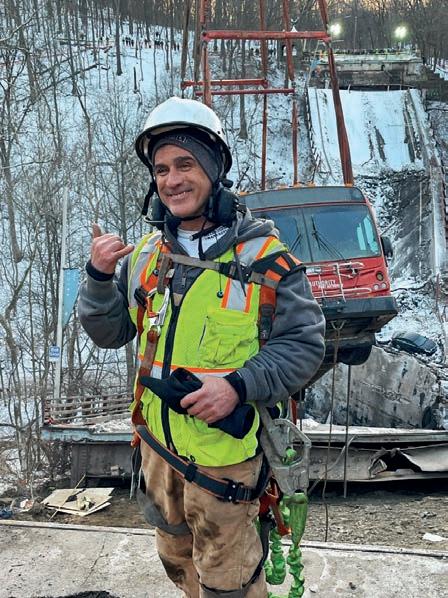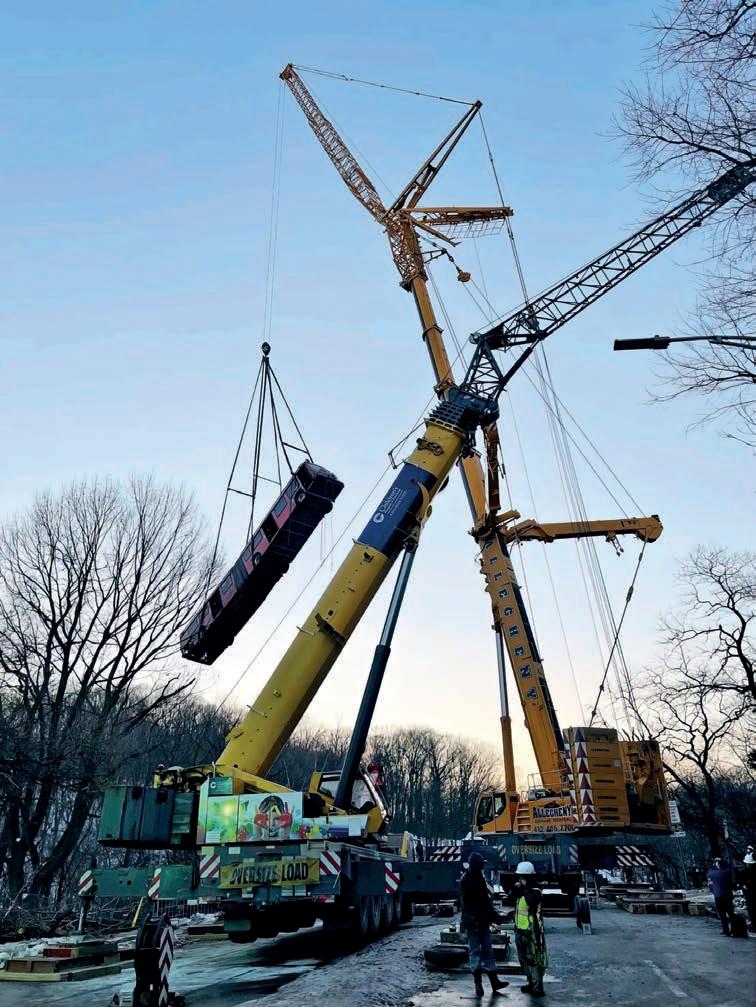
4 minute read
Bridge collapse requires bus lift rescue
US BRIDGE COLLAPSE REQUIRES BUS LIFT RESCUE
Allegheny Crane and Rigging successfully rescued a bus and cars trapped by a bridge collapse. President of Allegheny Crane Rentals Kyrk Pyros explained the complexities of the project following the bridge collapse near Frick Park, Pittsburgh in the United States.
Allegheny deployed its Liebherr LTM 1350-6.1 and Grove GMK5275.
THERE WERE A NUMBER OF HOSPITALISATIONS
as a result of the bridge collapse and at least three people rushed to hospital were on the bus. Miraculously there were no deaths. Understandably, the bridge deck had to be cleared of vehicles before any recovery work could begin.
Allegheny Crane Rentals utilised a Liebherr LTM 1350-6.1 with Y guides and luffer to perform the lift with the most challenging aspect recovering the bus. The second crane, a Grove GMK5275, 275-tonne capacity all terrain featured luffing jib and utilised 63.71m of the main boom was also used in the recovery.
The Port Authority bus was the most challenging aspect of the lifts. It was situated some 26 metres below the crane and weighed in at 21 tonnes, measuring 18m in length, 2.5m in width, and 3m in height.
The bus was an articulated model, posing an even greater challenge for the planners as, once the lift began, it had potential to shift the centre of gravity on the load. The Allegheny crew began the task of solidifying the bus to ensure it could be lifted and not a pose a risk of shifting and placing the crew in danger.
“We used Mcgann and Chester’s 90t rotator wrecker to pull up the bus to get it straightened out so we could rig and block-knuckle it,” said Pyros.
“To prevent the bus from moving, we fixed cribbing, which was braced to the structural frame members inside the bus while it was being suspended by the wrecker, then we rigged the bus from the outside with our rigging plan.
“Rigging like this is an art, where engineering and style collide for a great solution. I am more of a naturalist, I keep it as it lays for simplicity and safety. We have the vision in place then we say: let’s go worst case scenario, everything that can fail, might fail, do we have a contingency for this?” Pyros said.
Lifting the 21t bus required

meticulous planning to keep it safe.
“We set up a temporary office in Frick Park Automotive and we are grateful we were able to access this during the lift. We were constantly updating and tweaking right up until the pick,” Pyros said.
“We had three engineers on this project from start to finish – Alex Delp, Hank Depasquale, and myself – and we were continually updating in real time and working together to ensure the project was completed successfully,” he said.
The lift itself required diligent and careful planning from Allegheny Crane and Rigging and all engineers were tasked with ensuring the lift was completed successfully.
“It was a great collaboration and team effort between public and private partnerships in the City of Pittsburgh,” Pyros said.
“The rigging weight came in at 462kg, the hook weight was 800kg, the hook height was 33m, and the materials used were kevlar and steel.”
Allegheny utilised over 140t of counterweight to successfully complete the lift.
The counterweight was easily added to the crane utilising Liebherr’s vast array of safety equipment, which included pedestals, hand railing, and hand holds.
The Liebherr LTM 1350-6.1 provided all the power Allegheny crew needed to lift the bus out of the ravine.
The drivetrain for the LTM 13506.1 is an eight-cylinder Liebherr turbo diesel with an output of 450kW. It has an automatic ZF gearbox with 12 forward gears and two reverse gears. The LTM 1350-6.1 has active rear axle steering, which allowed it to be manoeuvred into place and ensure the lift was able to occur.
The Liebherr LTM1350-6.1 is extremely compact, which allowed it to reach its position with little issue.
The chassis length is 15.37m, the minimum turning radius is 12.69m, the chassis width is 3m and the tail swing is only 3m. The crane has air-powered disc brakes, giving it a strong stopping capability and giving the Liebherr higher braking power and braking control. The air-controlled brakes have no brake fading at higher temperatures and a longer service life.
A lift of this magnitude requires several important parts to ensure it is completed successfully. The matting that was utilised was an axion structure and reinforced with half inch-thick steel. The specs for the matting itself were: timber width 304mm; timber depth 304mm; mat length 6m; and mat width 2.5m.
The recovery of the bus was admired by residents of Pittsburgh, making local news channels and showing the wider community the importance of the crane industry. Pyros acknowledged the work of the rescue teams and his own team in the successful recovery of the bus.
“It was a great collaboration between public and private partnerships in the City of Pittsburgh,” he said.
“It was a true team effort from all of those involved that allowed us to recover the vehicle.
“It combined the FBI, secret service, National Transportation Safety Board Urban Search And Rescue 51, Pittsburgh Fire, Pittsburgh Police, public works, Mcgann and Chester, KP Builders and Allegheny Crane to complete the lift,” Pyros said.

President of Allegheny Crane Rentals Kyrk Pyros.
The load included a hook weight of 800kg, total rigging weight of 462kg and the bus weighed 21t.










